|
|
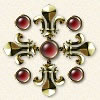 |
17th
c. Lace
Gallery
& Identification
|
 |
All images
open in a new window
| Please
note that I generously received permission from Pat Earnshaw,
the copyright holder, and from Shire Publications, the company
which published the book these images are from, to display
8 photos of lace, where indicated, on this website from her
book The Identification of Lace. This means that the
permission is exclusively for display here, and you may not
use these images elsewhere. The remaining photos on this website
were taken by B. Levick in the V&A Museum, London in June
1999. You may not use them elsewhere without my expressed
written permission. Thank you for your understanding. |
Pat Earnshaw:
The
Identification of Lace. Shire Publications Ltd. ISBN 0-7478-0237-8
Lace in Fashion: From the Sixteenth to the Twentieth Centuries.
Gorse Publications. ISBN 0-9513891-3-0
Furthermore, please take a look at Shire
Publication's official website, who so generously gave me permission
as well.
 |
Needlepoint
Lace
|
 |
Early Needlepoint
Lace
The most important
characteristic of all needlepoint laces is the buttonhole stitch,
and therefore the appearance of needlepoint resembles embroidery.
This lace was worked with a very fine flax or linen thread. Needlepoint
lace was the one exquisite lace of all which was most fashionable
throughout the 17th century.
The earliest needlepoint are Reticella and Punto in Aria.
Both show a characteristic geometrical design.
 Reticella developed from open-work embroidery by discarding the woven linen
and replacing it with needlewoven strands, laid over a pattern, Reticella took the step from embroidery to lace. The designs,
executed with closely worked buttonhole stitches, remained mainly
geometrical. Reticella developed from open-work embroidery by discarding the woven linen
and replacing it with needlewoven strands, laid over a pattern, Reticella took the step from embroidery to lace. The designs,
executed with closely worked buttonhole stitches, remained mainly
geometrical.
 Punto
in Aria was primarily used for edging, not being connected in
the process of making to the material it decorated. The edges were
more or less sharply pointed, as can be seen on portraits (ruffs
and cuffs) of the 16th and 17th centuries. Punto
in Aria was primarily used for edging, not being connected in
the process of making to the material it decorated. The edges were
more or less sharply pointed, as can be seen on portraits (ruffs
and cuffs) of the 16th and 17th centuries.
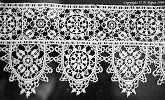 |
Reticella,
late 16th century
V&A Museum |
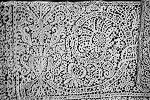 |
Punto
in Aria, late 16th century
(I'm not 100% certain that this is Punto in Aria. Sorry.)
V&A Museum |
Venetian
Needlepoints
Venetian needlepoints
can be divided in six different types (from the early 17th to the
mid 18th centuries), the first three being raised, and the second
three being flat.
 Gros
Point motifs can be bigger than 50 mm, with a wide cordonnet
padded with picots. Gros
Point motifs can be bigger than 50 mm, with a wide cordonnet
padded with picots.
 Rose
Point shows smaller flowers and the cordonnet was less raised.
Although Gros Point and Rose Point seem to be very
different, many intermediate examples existed as well. Rose
Point shows smaller flowers and the cordonnet was less raised.
Although Gros Point and Rose Point seem to be very
different, many intermediate examples existed as well.
 Point
de Neige is the peak of the trend to make flowers smaller, while
being built up in delicate layers, together with increasingly decorative
brides. Point
de Neige is the peak of the trend to make flowers smaller, while
being built up in delicate layers, together with increasingly decorative
brides.
 Point
Plat was a closely worked lace in a similar scrolling design
of the raised points, but the flowers, instead of being padded,
were filled with many different designs. It was mainly used for
edging linen aprons. Point
Plat was a closely worked lace in a similar scrolling design
of the raised points, but the flowers, instead of being padded,
were filled with many different designs. It was mainly used for
edging linen aprons.
 Coralline names a simpler form of Point Plat, where the fillings are limited
in type. Coralline names a simpler form of Point Plat, where the fillings are limited
in type.
 Resau
Venise was a flat needlepoint with a very fine texture and an
elaborate design of formalised lilies, filled with a multitude of
ornaments. Resau
Venise was a flat needlepoint with a very fine texture and an
elaborate design of formalised lilies, filled with a multitude of
ornaments.
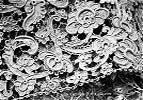 |
Gros
Point, second half of 17th century. Flax
thread, padded. Detail of a male lace collar, a Rabat. V&A
Museum |
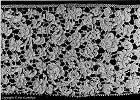 |
Rose
Point, middle of 17th century. Copyright © Pat Earnshaw.
From The Identification of Lace, by Pat Earnshaw. Shire
Publications Ltd. With permission |
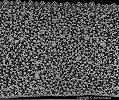 |
Point
de Neige, second half of 17th century. Copyright ©
Pat Earnshaw. From The Identification of Lace, by Pat
Earnshaw. Shire Publications Ltd. With permission |
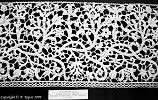 |
Point
Plat. Italian (Venetian). V&A Museum |
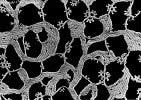 |
Coralline. Detail. A degenerate form of Point Plat. Copyright
© Pat Earnshaw. From The Identification of Lace,
by Pat Earnshaw. Shire Publications Ltd. With permission |
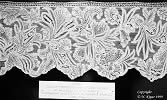 |
Point
de Venise. End of 17th century
V&A Museum |
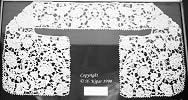 |
Female
lace collar, worn like a bertha around the low collar of the
mantua, on top of the bodice. Made from Venetian Gros Point,
second half of 17th century. V&A Museum. |
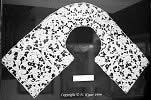 |
Male
lace collar, a so-called Rabat. Made from Venetian Gros
Point, second half of 17th century. V&A Museum. |
French Needlepoints
 Point
de France developed in Alecon and in Normandy from 1665 on.
Louis XIV gave this superb needlepoint the name Point de France and it was adopted by the entire French court, not only decorating
garments but also towels and dressing tables. The motifs were relatively
small, with only a slightly raised cordonnet, with its most distinctive
feature being a ground of brides picotées arranged in a series
of hexagons. Point
de France developed in Alecon and in Normandy from 1665 on.
Louis XIV gave this superb needlepoint the name Point de France and it was adopted by the entire French court, not only decorating
garments but also towels and dressing tables. The motifs were relatively
small, with only a slightly raised cordonnet, with its most distinctive
feature being a ground of brides picotées arranged in a series
of hexagons.
 Point
de Sedan was a more free-flowing and less symmetrical form of Point de France, produced at the border between France and
Flanders. Point
de Sedan was a more free-flowing and less symmetrical form of Point de France, produced at the border between France and
Flanders.
 |
Point
de France. Cravat, detail. Second half of 17th century.
V&A Museum |
 |
Point
de France. Cravat, detail. Late 17th century.
V&A Museum |
The Making
of Needlepoint Lace
 |
The
pattern was drawn on a strip of parchment, and then the outlining
threads were tacked along the design. All spaces between them
were then filled with buttonhole stitches, to be linked as
a last step with brides to hold the toile together.
Copyright © Pat Earnshaw. From The Identification
of Lace, by Pat Earnshaw. Shire Publications Ltd. With
permission |
Tape-based
Lace
 Mezzo
Punto was made during the 17th century in Italy. It used a woven
or bobbin tape of even width which was folded and then fixed. It
imitated the fine needlepoint laces, but never came near to them.
The example below has needlepoint fillings. Mezzo
Punto was made during the 17th century in Italy. It used a woven
or bobbin tape of even width which was folded and then fixed. It
imitated the fine needlepoint laces, but never came near to them.
The example below has needlepoint fillings.
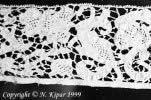 |
Tape-based
Italian lace.
V&A Museum |

 |
Bobbin
Laces
|
 |
The characteristic
of bobbin lace is, naturally, the use of bobbins to pull the threads
taut and facilitate handling while they are twisted, crossed or
plaited, to form a more or less woven material. Pins are stuck into
the pillow according to the pricked design, to hold and guide the
threads during the process of the lacemaking. The number of bobbins
varies from about a dozen to several hundred depending on the width
and the complexity of the design.
Italian
Bobbin Laces
 Genoese lace developed in the 16th century, imitating in its rigid tooth-like
triangles the contemporary needlepoint lace Punto in Aria.
When the fashion of collars turned towards soft falling bands, Genoese
changed accordingly, being scalloped edged now and made of thicker
thread, densely worked. By the mid 17th century Genoese lace
went out of fashion. Genoese lace developed in the 16th century, imitating in its rigid tooth-like
triangles the contemporary needlepoint lace Punto in Aria.
When the fashion of collars turned towards soft falling bands, Genoese
changed accordingly, being scalloped edged now and made of thicker
thread, densely worked. By the mid 17th century Genoese lace
went out of fashion.
 Milanese lace was made from the 17th century up to the late 18th century
and was made mainly as flounces or entire collars or apron edgings
rather than as narrow edging like Genoese. Milanese was, in contrast to Genoese, boldly flower patterned and free-flowing. Milanese lace was made from the 17th century up to the late 18th century
and was made mainly as flounces or entire collars or apron edgings
rather than as narrow edging like Genoese. Milanese was, in contrast to Genoese, boldly flower patterned and free-flowing.
 Venetian bobbin is a very rare 17th century lace, which looked in its closely
worked pattern like an imitation of the needlepoint lace Point
Plat, with myriad of tiny flower buds. Venetian bobbin is a very rare 17th century lace, which looked in its closely
worked pattern like an imitation of the needlepoint lace Point
Plat, with myriad of tiny flower buds.
Dutch and
Flemish Bobbin Laces
 Dutch lace is very rare and only known from the 17th century. Its look
is very thick and strong but in no means clumsy or rigid. Very fine
flax was used, thickly spun and closely worked. The formalised design
appeared like rounded, bunched bouquets of flower heads. Dutch lace is very rare and only known from the 17th century. Its look
is very thick and strong but in no means clumsy or rigid. Very fine
flax was used, thickly spun and closely worked. The formalised design
appeared like rounded, bunched bouquets of flower heads.
 Flemish,
17th century. This lace is known in several forms,one of them resembling Genoese collar lace, in its repetition of shallow scallops
which dissected into fan shapes. Another form had deep scallops
made of filled circles. Flemish,
17th century. This lace is known in several forms,one of them resembling Genoese collar lace, in its repetition of shallow scallops
which dissected into fan shapes. Another form had deep scallops
made of filled circles.
 Flemish,
18th century. This lace is strikingly different from the earlier
lace. Toile and reseau were separately worked, very similar to the
contemporary Milanese lace, so that they sometimes became
indistinguishable. Flemish,
18th century. This lace is strikingly different from the earlier
lace. Toile and reseau were separately worked, very similar to the
contemporary Milanese lace, so that they sometimes became
indistinguishable.
 Brabant was mainly made into wide flounces in the 18th century of a bold,
extravagant design, but the thread which was used was inferior to
other laces' threads. Brabant was mainly made into wide flounces in the 18th century of a bold,
extravagant design, but the thread which was used was inferior to
other laces' threads.
 Binche was a very fine straight-edged lace with a design of scattered spots. Binche was a very fine straight-edged lace with a design of scattered spots.
 Valenciennes was similar to Binche in its translucent texture but greatly
advanced to it in its design of gently curving flowers sweeping
over a snowflake ground. Valenciennes was similar to Binche in its translucent texture but greatly
advanced to it in its design of gently curving flowers sweeping
over a snowflake ground.
 Antwerp lace is mostly characteristic for its design of a two-handled vase
overspilling with flowers in the form of tulips or lilies with long
stems. Antwerp lace is mostly characteristic for its design of a two-handled vase
overspilling with flowers in the form of tulips or lilies with long
stems.
 Mechlin,
or Malines lace is already recorded from the middle of the
17th century, being an almost transparent lace with a complexity
and richness of design resembling early Valenciennes lace.
During the reign of Queen Anne, in 1713, Mechlin lace was
the favourable lace of the English court. Mechlin,
or Malines lace is already recorded from the middle of the
17th century, being an almost transparent lace with a complexity
and richness of design resembling early Valenciennes lace.
During the reign of Queen Anne, in 1713, Mechlin lace was
the favourable lace of the English court.
 Point
d'Angleterre or Brussels bobbin lace dates in its earliest
form from the late 17th century. Its design represented flowers,
people and animals, sometimes even biblical scenes in a quite realistic
fashion. Point
d'Angleterre or Brussels bobbin lace dates in its earliest
form from the late 17th century. Its design represented flowers,
people and animals, sometimes even biblical scenes in a quite realistic
fashion.
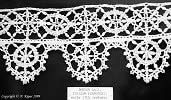 |
Genoese bobbin lace,
early 17th century.
V&A Museum. |
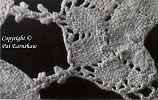 |
Milanese bobbin lace, late 17th century. Detail. Copyright © Pat
Earnshaw. From The Identification of Lace, by Pat Earnshaw.
Shire Publications Ltd. With permission |
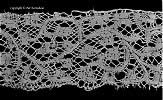 |
Flemish
'Peasant lace'
17th century. Copyright © Pat Earnshaw. From The Identification
of Lace, by Pat Earnshaw. Shire Publications Ltd. With
permission |
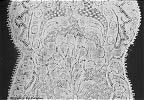 |
Valenciennes bobbin lace,
part of a lappet, ca. 1700. Copyright © Pat Earnshaw.
From The Identification of Lace, by Pat Earnshaw. Shire
Publications Ltd. With permission |
 |
Flemish bobbin lace. 17th century. V&A Museum
Note the difference in design and execution to the later Flemish bobbin lace below. |
 |
Italian Milanese, part of a flounce, second half of 17th century.
Detail.
V&A Museum. |
 |
Flemish bobbin lace, part of a flounce. Detail. Late 17th or early
18th century. V&A Museum |
|
|
Lace for
Clothing
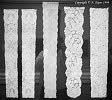 |
Different
lappets from caps and Fontanges. Late 17th century to early
18th century. V&A Museum. |
 |
Stomacher
made from lace, to be worn with a Mantua. Early 18th century.
V&A Museum |

Female
Costumes
Indoor
Garments | Footwear | Accessories | Hairstyles | Head-dresses | Development
of the Fontange
Hairstyles
by Vermeer | Dress
Colours by Vermeer | Head-dresses
by Vermeer
Costume Focus Headwear & Neckwear | Costume
Focus Working Women
Costume
Focus Children's Clothing
Ladies'
Costume Quotes
Male
Costumes
Gentlemen's
Baroque Clothing
Indoor
Garments | Footwear | Accessories | Hairstyles | Head-dresses
Costume
Colours by Vermeer | Hair-
and Head-dresses by Vermeer
Gentlemen's
Costume Quotes
~ ~ ~ ~ ~ ~ ~ ~ ~ ~ ~ ~ ~
Embroidery Gallery | Gallery of Needlework
Engravings
Lace Gallery & Identification | Glossary
Contents © N. Kipar 1997 |









